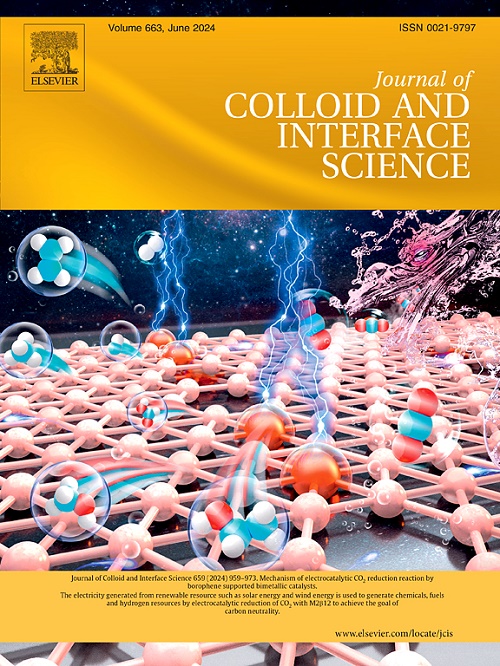Modifying d–p orbital hybridization of Ni/FeO species by high-valence ruthenium doping to enhance oxygen evolution performance
IF 9.4
1区 化学
Q1 CHEMISTRY, PHYSICAL
引用次数: 0
Abstract
The electron distribution of catalysts can be modulated by high-valence metal doping, thus enhancing the intrinsic activity. Herein, we adopt Ru modification to adjust the d–p orbital hybridization of Ni-Fe oxyhydroxides, significantly increasing the oxygen evolution reaction (OER) activity. The amorphous NiFe0.5Ru0.1OxHy catalyst synthesized by sol–gel method exhibits excellent OER activity, far superior to commercial RuO2. In situ Raman and XPS results confirm that the NiOOH/FeOOH active species gradually form with increasing applied voltage. Density functional theory (DFT) calculations reveal that high-valence Ru dopants can effectively regulate the hybridization of d–p orbital of Ni/Fe![]() O, significantly increase the electron density around Fermi level, promote charge transfer, make them have more anti-bonding orbitals, enhance the binding ability of active sites to intermediates, reduce the reaction energy barrier of the rate-determining step (H2O → *OH), and thus improve the OER activity. In addition, NiFeRuOxHy as a cathode catalyst in a rechargeable zinc-air battery shows an outstanding cycle life of 600 h. This study provides a promising hybrid orbital method for designing high-performance OER catalysts for water splitting and rechargeable zinc-air batteries.
O, significantly increase the electron density around Fermi level, promote charge transfer, make them have more anti-bonding orbitals, enhance the binding ability of active sites to intermediates, reduce the reaction energy barrier of the rate-determining step (H2O → *OH), and thus improve the OER activity. In addition, NiFeRuOxHy as a cathode catalyst in a rechargeable zinc-air battery shows an outstanding cycle life of 600 h. This study provides a promising hybrid orbital method for designing high-performance OER catalysts for water splitting and rechargeable zinc-air batteries.

通过掺杂高价钌来改变 Ni/FeO 物种的 d-p 轨道杂化,从而提高氧进化性能。
催化剂的电子分布可以通过高价金属掺杂进行调节,从而提高其内在活性。在此,我们采用 Ru 修饰来调整 Ni-Fe 氧氢化物的 d-p 轨道杂化,从而显著提高了氧进化反应(OER)的活性。采用溶胶-凝胶法合成的非晶态 NiFe0.5Ru0.1OxHy 催化剂表现出优异的 OER 活性,远远优于商用 RuO2。原位拉曼和 XPS 结果证实,随着施加电压的增加,NiOOH/FeOOH 活性物种逐渐形成。密度泛函理论(DFT)计算表明,高价Ru掺杂物能有效调节Ni/FeO的d-p轨道杂化,显著增加费米级附近的电子密度,促进电荷转移,使其具有更多的反键轨道,增强活性位点与中间产物的结合能力,降低决定速率步骤(H2O → *OH)的反应能垒,从而提高OER活性。此外,NiFeRuOxHy 作为可充电锌-空气电池的阴极催化剂,显示出 600 小时的出色循环寿命。这项研究为设计用于水分离和可充电锌-空气电池的高性能 OER 催化剂提供了一种前景广阔的混合轨道方法。
本文章由计算机程序翻译,如有差异,请以英文原文为准。
求助全文
约1分钟内获得全文
求助全文
来源期刊
CiteScore
16.10
自引率
7.10%
发文量
2568
审稿时长
2 months
期刊介绍:
The Journal of Colloid and Interface Science publishes original research findings on the fundamental principles of colloid and interface science, as well as innovative applications in various fields. The criteria for publication include impact, quality, novelty, and originality.
Emphasis:
The journal emphasizes fundamental scientific innovation within the following categories:
A.Colloidal Materials and Nanomaterials
B.Soft Colloidal and Self-Assembly Systems
C.Adsorption, Catalysis, and Electrochemistry
D.Interfacial Processes, Capillarity, and Wetting
E.Biomaterials and Nanomedicine
F.Energy Conversion and Storage, and Environmental Technologies

 求助内容:
求助内容: 应助结果提醒方式:
应助结果提醒方式:


